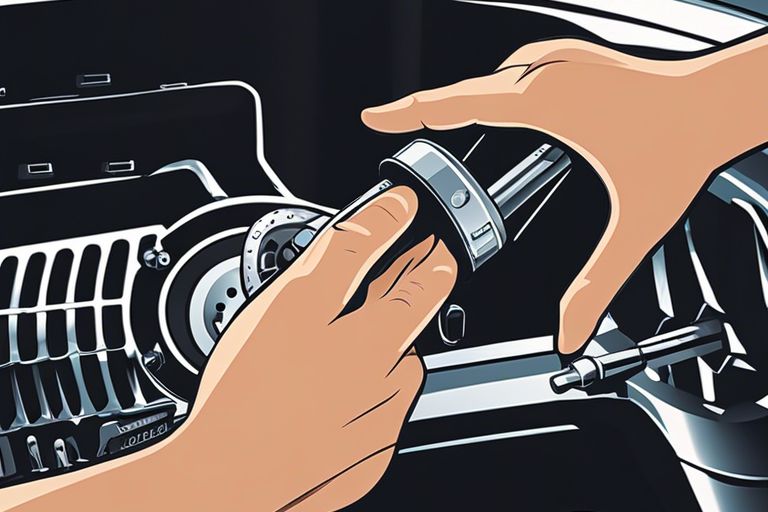Are you experiencing issues with your vehicle’s ABS and traction control systems? It could be a dirty or malfunctioning wheel speed sensor causing the problem. Cleaning your wheel speed sensor is a crucial maintenance task that can prevent costly repairs and ensure your safety on the road. In this informative blog post, we will guide you through the step-by-step process of cleaning your wheel speed sensor, helping you to restore proper functionality to your vehicle’s essential safety systems. Failure to maintain your wheel speed sensor properly can lead to dangerous driving conditions and compromised braking ability, so it is important to take the time to perform this maintenance task regularly.
Identifying the Wheel Speed Sensor
The Wheel Speed Sensor, also known as the WSS, is an important component of your vehicle’s anti-lock braking system (ABS). Its primary function is to monitor the speed of each wheel and send the data to the ABS control module. This allows the system to adjust the braking force to prevent the wheels from locking up during hard braking or slippery road conditions.
Location in Different Vehicle Models
The location of the WSS varies from one vehicle model to another. In most cases, you can find the sensor mounted on or near the wheel hub or brake rotor. However, some vehicles may have the sensor integrated into the wheel bearing or the steering knuckle. Your vehicle’s owner’s manual or a specific repair guide for your make and model can help you locate the WSS on your vehicle.
Recognizing Signs of a Dirty Sensor
When the WSS becomes dirty or contaminated, it can cause inaccurate readings and compromise the performance of your ABS. As a result, you may experience symptoms such as an ABS warning light on your dashboard, erratic or pulsating brake pedal, or the ABS system engaging unnecessarily during normal driving. Ignoring these signs can lead to decreased braking efficiency and compromised vehicle control, particularly in emergency braking situations. The best way to confirm if the sensor is dirty is to visually inspect it for any debris, dirt, or metal shavings that may be interfering with its operation.
Preparing to Clean the Wheel Speed Sensor
Some wheel speed sensor cleaning procedures can be done yourself, saving you time and money. Before you start cleaning the wheel speed sensor, it’s important to gather the necessary tools and prepare yourself for the task. If you need a guide on how to do this, you can refer to this article on How To Clean ABS Wheel Speed Sensor Yourself.
Safety Precautions
Before you start working on cleaning the wheel speed sensor, it’s important to ensure that your safety comes first. Always remember to disconnect the battery before working on the sensor to avoid electric shock. Additionally, make sure to work in a well-ventilated area to avoid inhaling any harmful fumes or airborne particles that may be released during the cleaning process.
Tools and Materials Needed
When preparing to clean the wheel speed sensor, you will need a few essential tools and materials to get the job done. This includes a jack and jack stands to raise the vehicle safely, a lug wrench to remove the wheel, a wire brush to remove any debris from the sensor, and a can of sensor-safe brake cleaner to clean the sensor thoroughly. You may also need a socket set and a digital multimeter depending on the type of sensor and the level of cleaning required. Make sure you have all these tools and materials ready before you begin.
Cleaning the Wheel Speed Sensor
For an in-depth guide on how to clean the ABS sensor without removing the wheel, you can refer to How To Clean The Abs Sensor Without Removing The Wheel?.
Step-by-Step Cleaning Procedure
If you’re experiencing issues with your wheel speed sensor, it’s essential to clean it before considering a replacement. Follow this step-by-step procedure to ensure your sensor is thoroughly cleaned and functioning optimally:
| Step | Description |
| 1 | Locate the wheel speed sensor behind the brake rotor and remove any debris or dirt surrounding it. |
| 2 | Use a sensor-safe cleaner to spray the sensor, ensuring all visible contaminants are removed. |
| 3 | Allow the sensor to air dry completely before reinstallation. |
Troubleshooting Common Issues during Cleaning
During the cleaning process, you may encounter common issues such as difficulty accessing the sensor or stubborn contaminants. If this occurs, ensure you have the proper tools and be gentle to avoid damaging the sensor. Additionally, seek professional help if you’re unable to resolve the issue on your own.

Preventative Measures and Maintenance
Your ABS wheel speed sensor is a crucial component of your vehicle’s safety system, and regular maintenance is essential to keep it functioning properly. By taking preventative measures and performing regular maintenance, you can avoid costly repairs and ensure that your ABS wheel speed sensor continues to operate effectively. Below, you’ll find some tips to help you maintain and care for your sensor.
Tips for Prolonged Sensor Life
In order to keep your ABS wheel speed sensor in optimal condition, it is important to regularly inspect and clean it. This can be done by visually checking for any debris or buildup around the sensor, and gently removing any dirt or grime using a soft brush or cloth. Additionally, avoid exposing the sensor to excessive moisture or harsh chemicals, as this can lead to corrosion and damage. Furthermore, regular inspection of the sensor’s wiring and connectors is crucial, as any fraying or damage can affect its performance. By following these maintenance steps, you can ensure that your ABS wheel speed sensor operates smoothly and efficiently, providing you with reliable braking performance. Knowing how to clean wheel speed sensor can help improve vehicle safety and prevent potential accidents.
When to Seek Professional Assistance
While performing regular maintenance is important, there may be instances where seeking professional assistance is necessary. If you notice any unusual noises or vibrations when braking, or if your ABS warning light illuminates on your dashboard, it’s important to have your ABS wheel speed sensor inspected by a qualified technician. Additionally, if you are unsure about how to properly clean or maintain the sensor, it’s best to consult with a professional who can provide the necessary expertise and ensure that the sensor is functioning correctly. Remember that neglecting to address issues with your ABS wheel speed sensor can compromise your vehicle’s safety and performance.

Cleaning Your Wheel Speed Sensor
Hence, it is important to regularly clean your wheel speed sensor in order to maintain its functionality and prevent any issues with your vehicle’s ABS, traction control, or stability control systems. By following a few simple steps, you can easily clean the sensor and ensure it continues to accurately measure your wheel speed. First, locate the sensor, which is typically located near the wheel hub. Next, use a sensor-safe cleaner and a soft brush to gently remove any dirt, debris, or corrosion that may have accumulated on the sensor. Finally, give the sensor a thorough rinse with water and allow it to dry completely before reinstalling it. By performing this maintenance regularly, you can avoid potential problems and keep your vehicle’s safety systems operating effectively.
FAQ
Q: What is a wheel speed sensor?
A: A wheel speed sensor is a device that detects the speed of a vehicle’s wheels and sends the information to the antilock brake system (ABS) and the traction control system.
Q: Why is it important to clean the wheel speed sensor?
A: Cleaning the wheel speed sensor is important because dirt, debris, and brake dust can build up and interfere with its ability to accurately measure wheel speed, leading to potential safety hazards and malfunctions in the ABS and traction control systems.
Q: How often should the wheel speed sensor be cleaned?
A: It is recommended to clean the wheel speed sensor during regular brake maintenance, typically every 20,000 to 30,000 miles, or if you notice any symptoms of a dirty or malfunctioning sensor, such as the ABS or traction control light illuminating on the dashboard.
Q: What is the process for cleaning the wheel speed sensor?
A: To clean the wheel speed sensor, start by removing the wheels to access the sensor. Use a gentle spray of brake parts cleaner or sensor-safe cleaner to remove any dirt and debris from the sensor and its surrounding area. Gently wipe the sensor clean with a soft cloth. Avoid using excessive force or harsh chemicals to prevent damage to the sensor.
Q: Are there any signs that indicate the wheel speed sensor needs cleaning or replacement?
A: Yes, common signs of a dirty or failing wheel speed sensor include the ABS or traction control warning light illuminating on the dashboard, erratic behavior from the ABS system, or unusual noises coming from the wheels. If any of these symptoms are present, it is important to inspect and clean the wheel speed sensor as needed or consult a professional for further diagnosis and potential replacement.
- How to Diagnose Bad Strut Mounts: Expert Tips for Quick Fixes - May 16, 2024
- How to Bypass Blower Motor Relay: 7 Expert Techniques - May 16, 2024
- How to Easily Check Ecu Ground: Essential Steps for Optimal Performance - May 16, 2024


